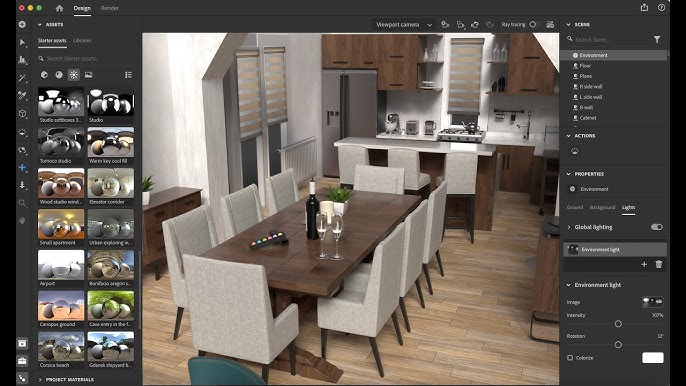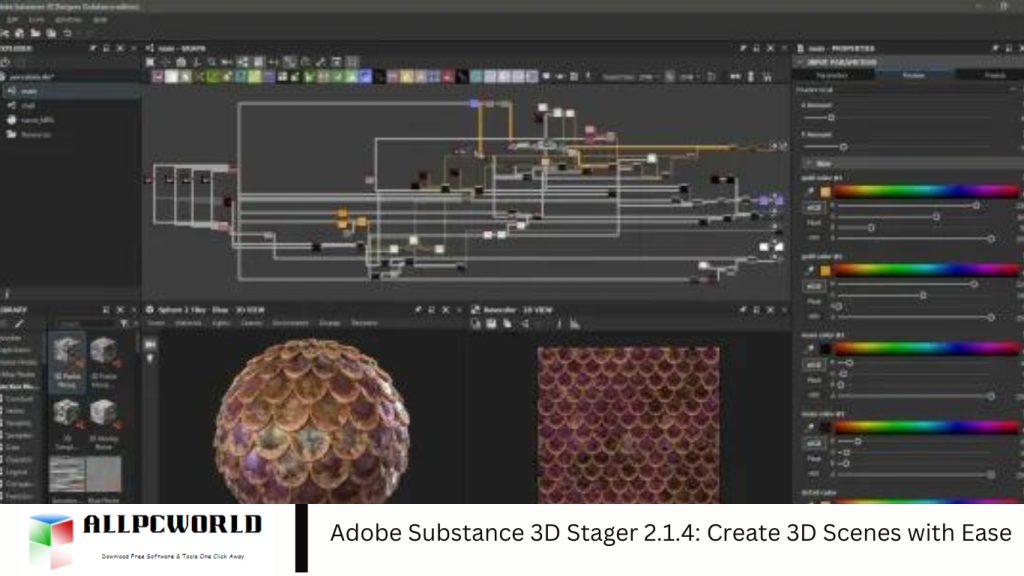Table of Contents
Landscape of 3D design, Adobe Substance 3D Stager 2.1.4 stands out as a premier software offering, empowering creators to fabricate captivating 3D scenes with unparalleled ease and efficiency. This comprehensive guide aims to delve into the multifaceted functionalities of Adobe Substance 3D Stager 2.1.4, equipping users with the knowledge and expertise to navigate its intricacies and leverage its full potential in crafting immersive 3D environments.
Introducing Adobe Substance 3D Stager
Substance 3D Stager offers an intuitive and artist-friendly interface that facilitates the entire scene creation process. Users can seamlessly import and arrange 3D models, assets, and materials within a virtual environment, allowing for dynamic and engaging compositions. The software supports various 3D formats, fostering compatibility and flexibility in incorporating diverse assets into scenes.

Lighting and Environment
Lighting is a crucial element in 3D scene creation, as it directly impacts the scene’s mood, atmosphere, and realism. Substance 3D Stager offers a range of lighting options, including point lights, spotlights, and area lights, allowing users to illuminate their scenes with precision. Additionally, the software provides HDR environments for realistic lighting and ambiance, with options to adjust environmental settings such as exposure, color temperature, and intensity.

Scene Composition and Layout
Effective scene composition is essential for creating visually appealing and coherent 3D scenes. Substance 3D Stager provides tools for placing, transforming, and arranging objects within the scene. Users can easily manipulate objects using intuitive controls and snapping options, ensuring precise positioning and alignment. Furthermore, the software supports scene organization through layers, groups, and hierarchies, allowing for better management and control of scene elements.
Collaboration and Exporting
Collaboration is essential to many creative projects, and Substance 3D Stager provides tools for facilitating collaboration among team members. Users can share projects and assets with collaborators, allowing seamless collaboration and feedback. Additionally, the software offers various export options for sharing 3D assets and renders with external applications or platforms. Substance 3D Stager supports popular file formats such as OBJ, FBX, USD, and glTF, ensuring compatibility with various software and pipelines.
Tips and Tricks for Workflow Efficiency
Efficient workflow practices can significantly improve productivity and streamline the 3D scene creation. Substance 3D Stager offers a range of features and tools to help users optimize their workflows. Keyboard shortcuts and hotkeys provide quick access to frequently used commands and functions, reducing the need for manual navigation. Additionally, workflow optimization techniques such as scene templates, presets, and automation can enhance efficiency by automating repetitive tasks and streamlining common workflows.
Adobe Substance 3D Stager Overview
Adobe Substance 3D Stager emerges as a powerful and innovative tool within the Adobe Substance 3D suite, dedicated to providing users with a comprehensive solution for scene design and visualization. Developed by Adobe, Substance 3D Stager stands out for its focus on empowering artists, designers, and 3D professionals with the ability to create captivating and realistic scenes for various applications, ranging from gaming and animation to product visualization.

Key Features of Adobe Substance 3D Stager
Adobe Substance 3D Stager is a feature-rich software designed to facilitate the creation of stunning 3D scenes easily. Here are some of its key features:
- Intuitive Interface: Substance 3D Stager boasts an intuitive and user-friendly interface, making it accessible to beginners and experienced users. The interface is designed to streamline the scene creation process, allowing users to focus on unleashing their creativity.
- Asset Management: The software offers comprehensive asset management tools, allowing users to import, organize, and manipulate 3D models, textures, and materials within their scenes. This includes support for various 3D file formats, ensuring compatibility with multiple assets.
- Substance Engine Integration: Substance 3D Stager integrates the powerful Substance Engine, enabling users to create and manipulate materials with a high degree of control. This integration enhances the realism of scenes by providing advanced material authoring capabilities.
- Substance Material Library: Users can access a vast library of Substance materials featuring a wide range of premade materials that can be easily applied to objects within their scenes. These highly customizable materials allow users to achieve lifelike textures and finishes.
- Real-time Rendering: Substance 3D Stager offers real-time rendering capabilities, providing instant feedback and previews of scene changes. This allows users to iterate quickly and adjust on the fly, resulting in a more efficient workflow.
- High-Quality Rendering: Besides real-time rendering, the software supports high-quality rendering settings for generating photorealistic images. This includes advanced features such as ray tracing, global illumination, and post-processing effects, enabling users to achieve stunning visual results.
- Animation and Timeline: Using keyframe animation techniques, users can create simple animations within Substance 3D Stager. The software features a timeline editor for animations, allowing users to adjust timing, easing, and interpolation.
- Collaboration Tools: Substance 3D Stager provides tools for collaboration among team members, allowing users to share projects and assets seamlessly. This facilitates collaboration and feedback, making it easier for teams to work on complex projects.
- Exporting and Compatibility: The software supports exporting assets and renders in various formats, ensuring compatibility with other software tools and platforms. This includes popular file formats such as OBJ, FBX, USD, and glTF, allowing users to integrate Substance 3D Stager into their existing workflows.
- Versatility: Substance 3D Stager is suitable for various applications and uses cases with its wide range of features and capabilities. Whether creating assets for video games, designing virtual environments, or visualizing products for marketing campaigns, Substance 3D Stager offers the flexibility and functionality needed to tackle any project.
Frequently Asked Questions
What is Adobe Substance 3D Stager 2.1.4?
Adobe Substance 3D Stager 2.1.4 is a software tool designed to create 3D scenes with ease. It is part of the Adobe Substance 3D suite and specifically focuses on empowering artists, designers, and 3D professionals to bring their creative visions to life in a virtual environment.
What are the critical features of Substance 3D Stager 2.1.4?
Substance 3D Stager 2.1.4 boasts an intuitive interface, asset management tools, Substance Engine integration, access to the Substance material library, real-time and high-quality rendering capabilities, animation and timeline features, collaboration tools, and compatibility with various file formats.
Who can benefit from using Substance 3D Stager 2.1.4?
Substance 3D Stager 2.1.4 is suitable for many users, including artists, designers, 3D professionals, game developers, animators, and anyone interested in creating 3D scenes for various applications such as gaming, animation, product visualization, and more.
What file formats are supported for importing assets into Substance 3D Stager 2.1.4?
Substance 3D Stager 2.1.4 supports a wide array of 3D file formats, including OBJ, FBX, USD, and glTF. This ensures compatibility and flexibility when incorporating diverse assets into scenes.
Can I create animations in Substance 3D Stager 2.1.4?
Substance 3D Stager 2.1.4 allows users to create simple animations using keyframe animation techniques. The software features a timeline editor for animations, allowing users to adjust timing, easing, and interpolation.
Is Substance 3D Stager 2.1.4 suitable for collaborative projects?
Substance 3D Stager 2.1.4 provides collaboration tools that allow users to share projects and assets with team members seamlessly. This facilitates collaboration and feedback, making it easier for teams to work on complex projects.
Can I export my scenes and renders from Substance 3D Stager 2.1.4?
Substance 3D Stager 2.1.4 supports exporting assets and renders in various formats, ensuring compatibility with other software tools and platforms. This includes popular file formats such as OBJ, FBX, USD, and glTF.
Is there a learning curve for using Substance 3D Stager 2.1.4?
While Substance 3D Stager 2.1.4 offers an intuitive interface, there may be a learning curve for users new to 3D scene creation. However, the software provides documentation, tutorials, and community support to help users get started and master its features effectively.
What are some everyday use cases for Substance 3D Stager 2.1.4?
Substance 3D Stager 2.1.4 can be used for various applications, including creating assets for video games, designing virtual environments for immersive experiences, visualizing products for marketing campaigns, and much more. Its versatility makes it suitable for a wide range of creative projects.
Where can I find support and resources for Substance 3D Stager 2.1.4?
Users can find support, documentation, tutorials, and community forums on the Adobe Substance website. Additionally, there are online communities and forums where users can connect with other Substance 3D Stager users for assistance and inspiration.
Conclusion
Adobe Substance 3D Stager 2.1.4 is a remarkable tool for creating captivating 3D scenes effortlessly. Its intuitive interface, powerful features, and seamless integration of the Substance Engine empower artists, designers, and 3D professionals to bring their creative visions to life quickly. Substance 3D Stager streamlines the entire scene creation process, from importing assets to rendering high-quality images, allowing users to focus on unleashing their creativity rather than grappling with technical complexities.

